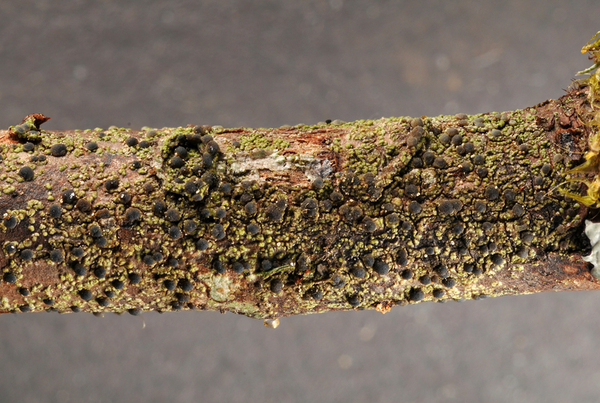Biatora sphaeroidiza (Vain.) Printzen & Holien
in Printzen, Bibl. Lichenol., 60: 119, 1995. Basionym: Lecidea sphaeroidiza Vain. - Acta Soc. Fauna Fl. Fenn., 57, 2: 399, 1934.
Synonyms:
Distribution: N - Frl (Printzen 1995).
Description: Thallus crustose, episubstratic, areolate or verrucose-areolate, greenish to grey-brown, when well-developed consisting of strongly convex areoles. Apothecia biatorine, rounded or slightly irregular in outline, 0.25-0.4(-0.7) mm across, pale grey to grey-black, partially also beige or orange-brown, often mottled and of different colours on the same thallus, with a flat to moderately convex disc, and a usually paler, thin, soon excluded proper margin. Proper exciple colourless or yellowish, of radially arranged hyphae; epithecium scarcely differentiated from the hymenium, colourless to orange- or grey-brown; hymenium colourless, rarely bluish grey; paraphyses simple or sparingly branched in upper part, the apical cells slightly swollen; hypothecium colourless or pale yellow. Asci 8-spored, clavate, with a K/I+ blue apical dome penetrated by a narrow, K/I– apical cushion surrounded by a narrow, deeply K/I+ blue zone, the wall K/I- but surrounded by an I+ red-brown, K/I+ blue outer layer, the ocular chamber relatively small, Biatora-type. Ascospores 1-celled, hyaline, (7.5-)9-11(-14) x 2.5-3.5 µm. Photobiont chlorococcoid. Spot tests: thallus K-, C+ orange, KC+ orange, P-; apothecial sections C+ orange. Chemistry: thallus and apothecia with thiophanic acid and asemone.Note: a boreal-montane species with an ecology similar to that of B. ocelliformis: it occurs both on conifers and deciduous trees and shrubs (e.g. Alnus, Salix, Sorbus, Vaccinium) in rather humid areas. The indicator values are tentative; the locality is in Slovenia, but very close to the Italian border.
Growth form: Crustose
Substrata: bark
Photobiont: green algae other than Trentepohlia
Reproductive strategy: mainly sexual
Commonnes-rarity: (info)
Alpine belt: absent
Subalpine belt: very rare
Oromediterranean belt: absent
Montane belt: extremely rare
Submediterranean belt: absent
Padanian area: absent
Humid submediterranean belt: absent
Humid mediterranean belt: absent
Dry mediterranean belt: absent

Predictive model
Growth form: Crustose
Substrata: bark
Photobiont: green algae other than Trentepohlia
Reproductive strategy: mainly sexual
Commonnes-rarity: (info)
Alpine belt: absent
Subalpine belt: very rare
Oromediterranean belt: absent
Montane belt: extremely rare
Submediterranean belt: absent
Padanian area: absent
Humid submediterranean belt: absent
Humid mediterranean belt: absent
Dry mediterranean belt: absent

Predictive model
 INDEX FUNGORUM
INDEX FUNGORUM
 GBIF
GBIF
 DOLICHENS
DOLICHENS


